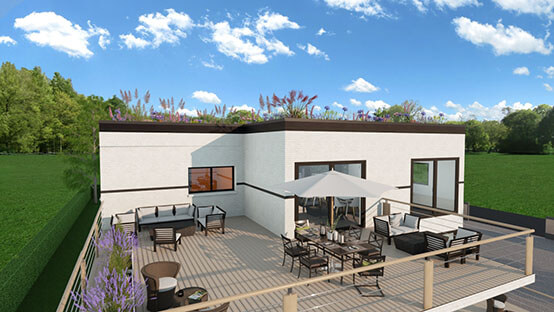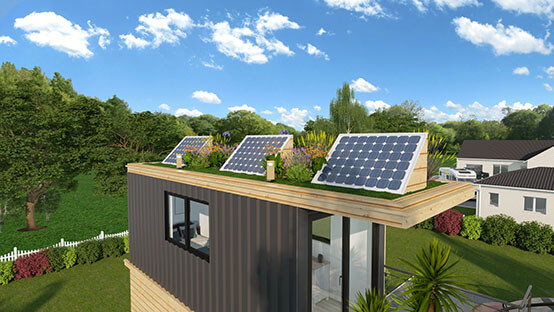Green roofs have been popular in Europe for years and their popularity is finally growing in North America as well.
- Are you ready to jump on the green roof construction trend?
- Thinking of adding some green roofs to your future construction projects?
In this 7-minute read, you’ll learn the basics of green roof construction.
Let’s start with…
What is Green Roofing?
Green roofing is when a layer of vegetation is used to cover all or part of a roof surface. It usually includes several layers such as:
- Waterproof membrane
- Root repellant layer
- Drainage system
- Growing medium (dirt)
- Plants
This creates a unique roofing system that not only looks cool but is better for your home and the environment around it.
Learn more about different types of green roofs in the next section.
Types of Green Roofing
Learn about the 3 main types of green roofing and which is best for your projects.
Extensive Green Roofs
Extensive green roofs are the most popular option for residential projects. They’re lightweight and very low maintenance.
They’re lightweight because the vegetation — moss, sedum, grass, small flowers — requires a very shallow dirt layer — just a few inches thick at most (up to 10 cm).
The choice of vegetation also helps cut down on maintenance. Builders choose hardy plants that thrive on their own without any extra maintenance or irrigations (except maybe in an extreme drought).
Intensive Green Roofs
Intensive green roofs are common to see on large commercial building projects.
They have thicker soil layers (up to 3 ft or 1 meter deep in places) to support larger plants, shrubs, bushes, and even small trees. Because of that, intensive green roofs look more like a garden than just a normal roof. That makes them a nice choice for creating a sort of mini park on the roof and expanding the building’s usable space.
But with larger plants and shrubbery comes extra maintenance since they need to be watered, pruned, and maintained. That means you have to plan a way to regularly access the plants.
Plus, the thicker soil layers mean the roof has to support a lot of extra weight. So that has to be taken into consideration when planning the structure of the building.
Semi-Extensive / Semi-Intensive Green Roof
A semi-extensive or semi-intensive green roof is somewhere in between the first two. It’ll have a deeper soil layer than an extensive roof in order to support a wider variety of plants. However, it won’t be deep enough to support greenery like shrubs and trees.
These are nice for commercial roofs where you want to give employees or clients a place to sit or walk outside in view of some vegetation but without the added maintenance of having an actual rooftop garden.
Think one of these might be the right fit for your project? Check out more benefits of green roofs in the next section.

Benefits of Green Roofing
So why should more builders “go green” with their roofs? Here are some of the top benefits for the public and for individual homeowners.
Public Benefits
- Controlled Stormwater Runoff: In urban areas stormwater runoff is a big problem to deal with. In nature, rainwater falls and either soaks into the ground or filters through vegetation before reaching the waterways. But in developed areas covered with asphalt and concrete, that doesn’t happen. Stormwater accumulates quickly and causes flooding and damage to local waterways. Green roofs help absorb and filter rainwater to keep this from happening. In fact, in summer months green roofs can absorb as much as 90% of the rain that falls on them.
- Reduce Urban Heat Island Effect: Urban buildings absorb and conduct a lot of heat. By covering rooftops with greenery, they absorb less heat. And with regular dew, precipitation and evaporation cycles, green roofs effectively help dissipate heat from the buildings.
- Improve Air Quality: More vegetation in urban areas means less dust, smog, CO2 and pollutants.
- Better Public Spaces: Green roofs, especially intensive green roofs, are easily turned into public areas like parks, gardens, and recreation areas that the community can enjoy.
- Job Creations: With the green roof construction market being relatively new in North America, there’s an opportunity for explosive job growth in the design, manufacturing, and installation of green roof products.
Personal Benefits
What about the personal benefits to homeowners?
- Increased Energy Efficiency: Green roofs are excellent insulators so they help naturally moderate the temperature inside the home. That means lower energy bills for homeowners.
- Noise Reduction: The thick natural barrier of a green roof on a residential home can reduce noise from outside by as much as 40 decibels.
- Increased Home Value: Green roofs not only increase a home’s energy efficiency but also add to the overall longevity of a home since most can last 40-50 years.
- Fire Retardation: But in the event of a house fire a green roof will not burn as easily or as hot as traditional roof materials.
- Marketability: With more homeowners being concerned about climate change, a green roof can be a huge selling point for a home.

Green Roof Design
What are some design considerations you should take into account when planning green roof construction? Here are two of the big ones.
Correct Components: Green roof construction is very different than a normal shingle or metal roof. In addition to the structure to support the extra weight, you’ll need:
- Waterproof membrane: This protects the underlying structure from moisture.
- Root Barrier: Plan roots can be destructive. This layer keeps the roots from damaging the waterproof membrane and roof structure.
- Drainage: Depending on the type of roof, this allows water to run off the roof underneath the soil layer. Some types also help retain water for the plant roots to use as needed.
- Geotextile Fabric: This prevents the soil from washing into the drainage layer and off the roof.
- Growing Medium (Soil)
- Vegetation: It’s best to choose vegetation that thrives locally.
Roof Pitch: The easiest green roofs to install and maintain are on flat roofs with up to a 10-degree slope.
They’re easier to maintain because:
- You can walk on the roof with less risk of damaging the vegetation.
- There’s less water runoff and less of a need to irrigate in drier months.
- There’s less of a risk of the vegetation sliding down the roof.
However, that doesn’t mean you can’t install a green roof on a pitched roof. With the correct green roofing products and a clever design, green roofs can be installed on up to a 12/12 pitch (45-degrees).
It can be hard to find home design software that can accommodate green roof designs. Cedreo is a great example of an easy-to-use program you can use to create 3D renderings of a home with green roofing.
Here’s how to do it:
- Once you’ve created your floor plan in Cedreo, head to the Roof tab.
- Add any type of roof, including a flat roof.
- Then go to the Materials tab.
- Open the materials catalog and choose the vegetation you want on the roof, such as grass.
- For intensive green roofs, you can even create a garden just like you would with the landscaping around the building.
Once you’ve finished adding your roof, head to the HD visuals tab to get a photorealistic rendering of the green roof to show your clients how it’ll look in real life!
Costs of a Green Roof
Green roofs can cost as little as $10 per square foot for extensive green roofs and as much as 30$ per square foot for intensive green roofs.
The final price will vary depending on:
- Depth of the growing medium
- Vegetation used
- Slope of the roof
- If irrigation is needed
- Roof accessibility
Even the cheapest green roofs are still considerably more expensive than normal shingled roofs. However, it’s important to remember that the benefits of a green roof can help offset its price.
For example…
A green roof on a residential home can help it quality for LEED (Leadership in Energy and Environmental Design) certification and even federal and state tax credits.
LEED gives you tools, a rating system, and credits to help guide you when planning environmentally-friendly construction. If your new buildings get LEED certified they can qualify for discounted insurance, tax credits and incentives, as well as renting out quicker and selling for more money than similar non-green homes.
So while the initial cost of a green roof is more, over time the incentives and environmental benefits help offset that cost.
Conclusion
Ready to plan your next residential project with green roof construction! Why not join thousands of other builders, remodelers, and designers who are already using Cedreo for their home design needs.
- Design an entire home — including a green roof — in as little as 2 hours
- Create both extensive and intensive green roofs
- Download 3D photorealistic renderings to impress clients and close more deals



